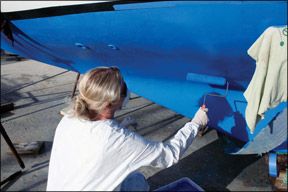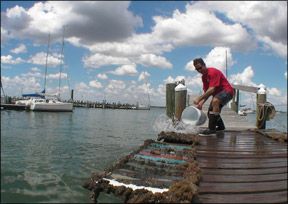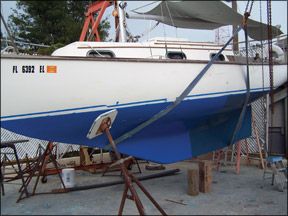Practical Sailor keeps a close watch on antifouling paints with good reason: Bottom jobs are among the most expensive regular maintenance projects that a sailboat owner must undertake. For the do-it-yourselfer, a bottom job doesn’t just cost money, it costs time as well. No one wants to spend their hours scraping barnacles while the boatyard neighbors are painting and launching.

In the interest of saving you both time and money, Practical Sailor recently inspected six different sets of antifouling test paints that had been submerged for varying amounts of time in the waters of Florida and New England. Each set was painted with more than five-dozen different products. The time they were immersed ranged from one to three years.
This months report covers the test paints performances after one and two years of immersion as well as an update on our field testing. Look for an update on the three-year test paints later this year.
WHAT WE TESTED
This article covers two identical sets of 65 antifouling paints that PS began testing in June 2009. One set was submerged at the Sarasota Sailing Squadron in Sarasota, Fla.; the other was placed in a canal in Tavernier, Fla., in the Florida Keys. (For the two-year report, including the panels tested in New England waters, see pages 16-17.) The Sarasota panels were inspected in January 2010 and June 2010, when the Tavernier panels also were inspected. The participating companies include Blue Water Paints, Flexdel, Interlux, Pettit, and Sea Hawk, and one newcomer, Copper Coat, an epoxy-copper blend that claims multi-year protection. An experimental stick-on antifouling, BoatKoat Laminate, also joined the fray.
The one-year test results are tabulated on pages 14 and 15 and are divided by paint category, hard and ablative. These two types of paint work differently, but for most boat owners, the key distinction is the maintenance regimens.
Hard paints resist scrubbing well and can usually be burnished smooth for racing. However, they leave behind resins and pigments that build up over time and eventually will need to be sanded off. Also, many hard paints lose their punch when they are stored out of the water for long periods.
Ablative paints wear away through use, so they don’t build up thick layers. Basic workboat ablatives slough away with water friction to expose more biocide. Other, copolymer ablatives release biocides at a controlled rate. Although some “hard” ablative paints resist light scrubbing and are suitable for trailering or racing, ablatives generally wont tolerate hard knocks like most hard paints.
Cuprous oxide (or copper thiocyanate in aluminum-friendly paints) is the primary biocide in most of the tested paints, but some also add algacides like Irgarol (NCN), and biocide boosters like zinc. The blends yield paints for specific needs: freshwater paints, aluminum paints, racing paints, water-based paints (easy for the do-it-yourselfer to apply), and eco-friendly paints. Weve flagged the best performer in each of these subcategories with Recommended checkmarks in the Value Guide tables.
Whatever type of paint you buy, check the application guidelines to be sure it is compatible with the paint you have on your boat. If in doubt about prep work, ask the paint maker for guidance.
HOW WE TESTED
The paint samples were applied to 6-foot-by-2-foot fiberglass panels for testing. Testers follow the makers instructions for preparation and application. For this test, there were 11 samples per test panel.
Prior to rating the paints, testers sluice the panels with a bucket of salt water. Paints were rated Excellent (no growth), Good (light soft growth), Fair (moderate to heavy soft growth), and Poor (hard growth). Any paint rated Fair or better is continuing to meet its designed purpose.
A Recommended paint is one that performs best overall or rates best among its specialized peers (best aluminum-safe paint, best water-based paint, best racing paint, etc.). The Budget Buy paints are the least expensive among Recommended paints.
Any antifouling test is subject to a number of variables, and we recommend supplementing our data with local knowledge from independent sources.
FINDINGS
At the 12-month mark, most paints kept away hard growth, but the slime coverage varied significantly. On several panels, the slime would require a good scrubbing or pressure wash to remove, as opposed to the simple sponge-off needed at six months. Except for the panels painted with freshwater-only paints, most hard growth could be removed with a good pressure wash or would require minimal scraping prior to re-coating.
As we have noted in previous tests, some of the better paints at the 12-month mark were not among the cleanest paints at six months. Many of the paints control the release of biocides, and once the biocide is depleted, potency can diminish quite rapidly. The 18-month mark is usually the point where the less potent paints drop out, so if you are looking for long-term protection, check the 24-month table on page 17. If you are inclined to buy water-based or copper-free paints, both of which have many excellent advantages, it is worth noting that very few of these paints make it to the winners circle in our two-year tests.
BLUE WATER
About a year ago, Blue Water Paints added some new chemists to its fold, and the companys latest paints (reformulated in 2009) continue to do well. Two Blue Water paints were among the few to earn a Good in both locations: the water-based Aqua Shield 45 Ablative and the economy hard paint Copper Shield 45.
Three other ablative paints scored Good in one of the two locations: the budget priced Copper Shield 45 Ablative, the aluminum-safe Kolor SCX, and the new self-polishing copolymer SPC 99. Blue Waters two Copper Pro Hard paints also earned a recommendation. Blue Water Paints can be ordered directly from the company website, but they are also available at boatyards and through distributor Donovan Marine (www.donovanmarine.com) under the MarPro label.

EPAINT
A specialist in copper-free paints,
Epaint was one of the big winners at the six-month mark, with three of its four paints coming out virtually clean of any growth in Sarasota. The paints continued to perform well at 12 months, although they fared better at the Sarasota site than in the Keys. Two hard paints, the popular racing paint ZO-HP and the water-based EP2000, remained very clean. The EP2000 is not compatible with other bottom paints, something to consider before changing brands. Also, because Epaints are photoactive, multiple coats near the waterline are essential to prolonging performance. The companys water-based ablative paint Ecominder succumbed to some heavy growth in Sarasota, but surprisingly, its single-season freshwater paint EP-21 looked very clean.
FLEXDEL
Flexdels aluminum friendly, low-copper Alumi-Koat II did not fare well in our test. It was one of the few paints that scored Poor in both locations after 12 months. The companys well-tested Aquagard is still holding hard growth at bay after 12 months. This water-based paint performed well in a head-to-head field test against Pettits Hydrocoat (March 2009). Although these water-based paints often hold up beyond the two-year mark in our panel tests, the Aquagard-Hydrocoat field test showed that barnacle growth can set in as early as 15 months on some of these paints.
INTERLUX
Interlux strongly promotes its Micron-series paints: Micron Extra, Micron CSC and Micron 66. These are top-tier, expensive copolymer paints that control the release of biocide over time. The self-polishing Micron 66, in particular, has done very well in long-term testing, although this paint is not recommended for fresh water. Micron Extra and Micron CSC have proven effective in field testing, but results have been mixed in our panel tests; both are among our top rated 24-month paints, but in this one-year group, the Micron Extra sample in the Keys was already allowing hard growth.
Two low-priced ablatives yielded interesting results: Fiberglass Bottomkote ACT (now sold as just ACT) was still fairly clean, and the soft workboat paint Bottomkote was doing well in the Keys, but had lost its potency in Sarasota.
In the hard paint category, water-based Bottomkote Aqua and VC Offshore scored well in their respective categories. Ultra, a paint that has done well in the past, failed to prevent barnacles at the six-month mark.
PETTIT/WEST MARINE
Pettits Trinidad and Trinidad SR hard paints have a long record of success in warmer climates, but some of Pettits other hard paints also showed good results at the 12-month mark. Vivid, which comes in white and a rainbow of colors, is still doing well in both locations. The economical West Marine Bottomshield, which uses Pettits new copper composite technology, looked very clean in the Keys and was still fighting barnacles in Sarasota.
According to Pettit, the copper composite technology delivers the same performance with less copper, allowing for a more economical price. Pettits experimental Vivid Eco, with the new biocide Econea, is still awaiting Environmental Protection Agency approval. The paint is no longer effective in Sarasota, but doing well in the Keys.
Trinidad SRs biocide boosters seemed to have given the paint an edge over regular Trinidad this year. Good-old Unepoxy, which had been a budget standby in past tests, bit the dust in Sarasota but is surviving in the Keys. In the ablatives, the West Marine CPP (Pettit Ultima SSA) and the West Marine PCA Gold (Pettit Ultima SR40) are doing well in both locations.

Several Sarasota barnacles settled on the panel painted with the experimental paint Ultima Fusion, but the Keys panel was still barnacle free. Pettits aluminum-friendly Vivid Free and Alumacoat SR paints (identical blends) remain among the better performing low-copper paints.
SEA HAWK
Sea Hawks Mission Bay, a no-copper paint designed to comply with the stricter environmental standards of California, is still doing well at 12 months. Also faring well is the companys new paint tailored for tropical cruisers, Islands 77 Plus. This biocide-boosted ablative paint has 7 percent less copper than its previous formula. The new blend appears to be at least as effective, if not more effective.
Sea Hawks affordable “semi-hard,” water-based ablative Monterey is still free of barnacles, as are its specialty paints for inflatable boats and transducers. The companys cleanest panel was Tropikote Biocide Plus, a high copper, dual biocide that offers multi-season protection. Its thin-film freshwater paint, Silver Bullet, failed, as did the only other such paints in this comparison, Interlux VC-17 and VC-17m.
ALTERNATIVE COATINGS
Our two alternative products, the three-part Copper Coat and the stick-on from BoatKoat Laminates, have been a disappointment. The Copper Coat, which blends actual copper granules into a two-part epoxy base, survived at six months, but at the 12-month mark, hard growth was apparent. The product is promoted as a 10-year coating, but it does require regular cleaning to expose fresh copper, and this could explain its sub-par performance in our test. Testers cleaned and lightly sanded the panel and returned it to the water. The experimental BoatKoat stick-on had failed at six months, but the maker has given us a newer more potent formula to test; stay tuned for those results.
CONCLUSION
This seasons report reinforces what weve stated before: Most modern paints designed for salt water are effective against hard growth for 12 months, but some are clearly better slime fighters. Another key point to keep in mind is that copper content is not always a reliable indicator of a paints effectiveness. Self-polishing paints, in particular, are very effective at fighting barnacles with lower copper contents.
“New” does not necessarily mean “good.” Several of the new and experimental paints PS has tested in recent years have not lived up to expectations. Paint prices are holding fairly steady at the moment, and you can still find a paint that provides at least 12 months of protection for around $120 per gallon.
If you are looking for an economical single-season ablative that is easy to apply, consider the water-based Blue Water Aqua Shield 45 or Sea Hawk Monterey. West Marines PCA Gold (Pettit Ultima SR-40) or Pettit Horizons are slightly more expensive solvent-based paints that will also serve well. To move up a tier in price and protection, opt for Micron 66 or Micron CSC. Aluminum-boat owners will do well with Pettits Alumacoat SR (same blend as Vivid Free) or Sea Hawk Mission Bay.
If you prefer a hard paint, Blue Waters Copper Shield 45 and West Marine Bottomshield are the most economical options. Blue Water Copper Pro SCX67 Hard and Pettit Vivid offer the next step up in protection and price, while either the EP2000 or Z0-HP will appeal to aluminum-boat owners, eco-fans, and racing sailors in search of a smooth bottom. If a multiseason paint that is loaded with copper is your cup of tea, then Sea Hawks Tropikote Biocide Plus and Pettits Trinidad SR are clear choices. Interluxs VC Offshore maintains its spot as another top pick for racers.
Anyone planning to keep their boat in the water for more than 12 months or hoping to get two summers of sailing out of their paint should also considered the 24-month report.




































